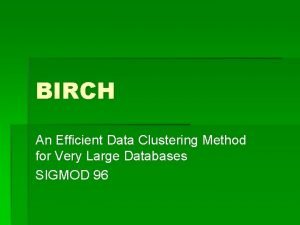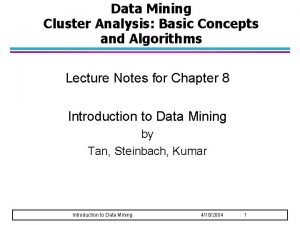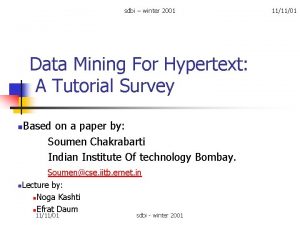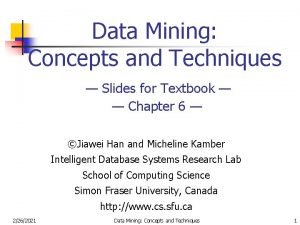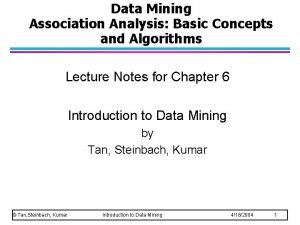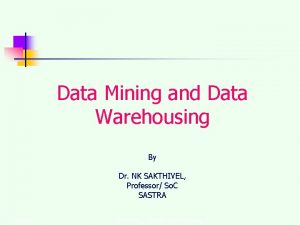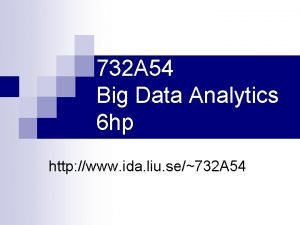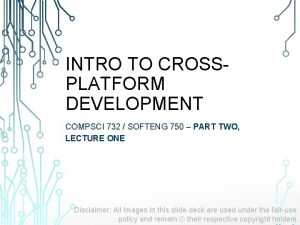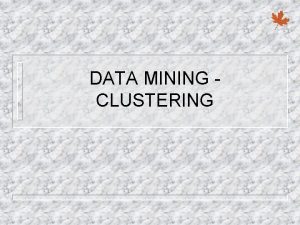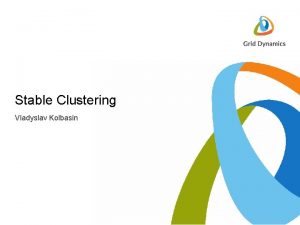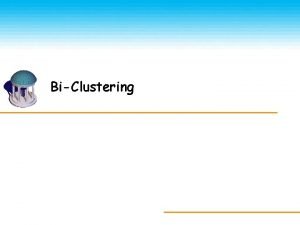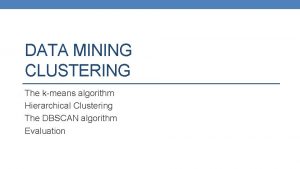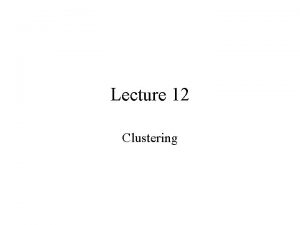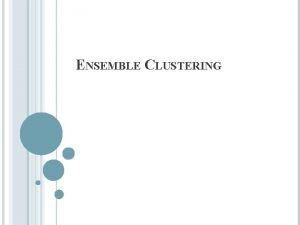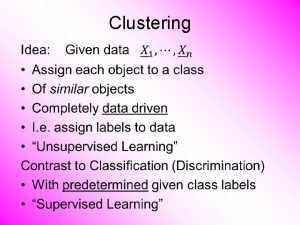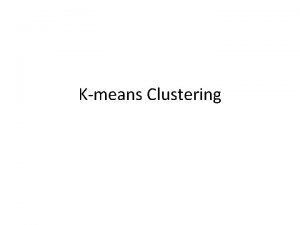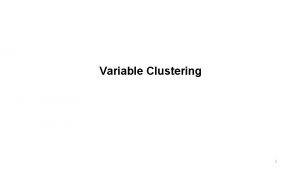732 A 02 Data Mining Clustering and Association


















- Slides: 18

732 A 02 Data Mining Clustering and Association Analysis • Constrained frequent itemset mining ………………… Jose M. Peña jospe@ida. liu. se

Constraints ®A constraint C(. ) is ® Monotone If C(A) then C(B) for all A B. ® E. g. A’ A. ® ® Antimonotone If C(A) then C(B) for all B A. ® Or, if not C(B) then not C(A) for all B A. ® E. g. support ≥ min_support. ® The apriori property applies to any antimonotone constraint. ®

Constraints ® sum(S. Price) ® min(S. Price) v is monotone (positive prices). v is monotone. ® range(S. Price) ® ® 15 is monotone. Itemset ab satisfies C So does every superset of ab Item Price a 40 b 0 c -20 d 10 e -30 f 30 g 20 h -10

Constraints ® sum(S. Price) v is antimonotone (positive prices). ® sum(S. Price) v is not antimonotone. ® range(S. Price) 15 is antimonotone. ® Itemset ab violates C ® So does every superset of ab Item Price a 40 b 0 c -20 d 10 e -30 f 30 g 20 h -10

Constraints Constraint v S S V Antimonotone no no Monotone yes S V min(S) v yes no no yes min(S) v max(S) v yes no no max(S) v count(S) v no yes no count(S) v no yes sum(S) v ( a S, a 0 ) yes no no yes range(S) v yes no no yes avg(S) v, { , , } support(S) No but convertible yes No but convertible no support(S) no yes

Apriori algorithm + any constraint Database D L 1 C 1 Scan D C 2 Scan D L 2 C 3 Scan D L 3 Constraint: Sum{S. price} < 5, where item price equals item id

Apriori algorithm + antimonotone constraint Prune search space Database D L 1 C 1 Scan D C 2 Scan D L 2 C 3 Scan D L 3 Constraint: Sum{S. price} < 5, where item price equals item id

Apriori algorithm + monotone constraint Does not prune search space but avoids constraint checking Database D L 1 C 1 Scan D C 2 Scan D L 2 ☺ Not in the output, since they don’t satisfy the constraint ☺ ☺ C 3 ☺ Scan D L 3 Constraint: Sum{S. price} ≥ 5, where item price equals item id

FP grow algorithm + antimonotone constraint Similar in Apriori (prune search space) Specific of FP grow (avoids constraint check)

FP grow algorithm + monotone constraint ® If C(α) then do not check C(. ) in TDB|α

Constraints ® avg(S. Price) v and avg(S. Price) ≥ v are neither monotone nor antimonotone. ® Convertible monotone ® If there exists an item order R such that ® ® ® If C(A) then C(B) for all A and B respecting R such that A is a suffix of B. E. g. avg(S. Price) ≥ v wrt decreasing price order. Convertible antimonotone ® If there exists an item order R such that ® ® ® If C(A) then C(B) for all A and B respecting R such that B is a suffix of A. Or, if not C(B) then not C(A) for all A and B respecting R such that B is a suffix of A. E. g. avg(S. Price) ≥ v wrt to increasing price order.

Constraints ® avg(X) 25 is convertible monotone wrt descending item price order R: < a, f, g, d, b, h, c, e> ® ® If an itemset d satisfies a constraint C, so do itemsets fd and afd, which have d as a suffix. avg(X) 25 is convertible antimonotone wrt ascending item price item order R-1: < e, c, h, b, d, g, f, a > ® If an itemset dfa satisfies a constraint C, so do itemsets fa and a, which are suffixes of dfa. Thus, avg(X) 25 is strongly convertible. ® Check that avg(X) 25 is also strongly convertible. ®

Constraints Constraint Convertible antimonotone Convertible monotone Strongly convertible avg(S) , v Yes Yes median(S) , v Yes Yes sum(S) v (items could be of any value, v 0) Yes No No sum(S) v (items could be of any value, v 0) No Yes No sum(S) v (items could be of any value, v 0) Yes No No ……

Constraints Monotone Antimonotone Strongly convertible Convertible antimonotone Inconvertible avg(S)-median(S)=0 Convertible monotone

FP grow algorithm + convertible antimonotone constraint ® Instead of ordering the items according to decreasing frequency, now the items are ordered according to the order R of the constraint. False: Such items can appear not only as suffix. False: No check is needed for those itemsets that are a suffix of α U β. The check is needed for the rest of items. True: α will be added as suffix to any itemset derived from TDB|α and the result respects R.

FP grow algorithm + convertible monotone constraint ® With ® monotone constraint If C(α) then do not check C(. ) in TDB|α ® With convertible monotone constraint Instead of ordering the items according to decreasing frequency, now the items are ordered according to the order R of the constraint. ® If C(α) then do not check C(. ) in TDB|α because α will be added as suffix to any itemset derived from TDB|α and the result respects R. ®

Exercise ® How would you incorporate covertible constraints in the Apriori algorithm ?

 Classification and clustering in data mining
Classification and clustering in data mining Mining complex types of data in data mining
Mining complex types of data in data mining Birch clustering algorithm
Birch clustering algorithm Clustering in data mining
Clustering in data mining K-means clustering algorithm in data mining
K-means clustering algorithm in data mining Flat and hierarchical clustering
Flat and hierarchical clustering Partitional clustering
Partitional clustering Rumus euclidean distance
Rumus euclidean distance Mining multimedia databases
Mining multimedia databases Association data mining techniques
Association data mining techniques Association rules in data mining
Association rules in data mining Association rules in data mining
Association rules in data mining Association rules in data mining
Association rules in data mining Association rules in data mining
Association rules in data mining Difference between strip mining and open pit mining
Difference between strip mining and open pit mining Difference between text mining and web mining
Difference between text mining and web mining Compsci 732
Compsci 732 Challenges n 732 ddl
Challenges n 732 ddl Softeng 750
Softeng 750


